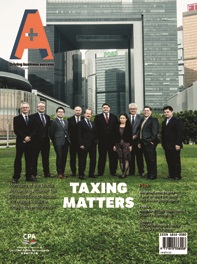Business models and people’s lives are increasingly being transformed by digitalization – yet tax policies around the world are struggling to keep pace. The push to reach an international consensus on how to tax multinational companies in a digital world could turn into a “David vs. Goliath struggle” between large economies and smaller ones, global tax experts have warned.
The Organization for Economic Cooperation and Development (OECD) is working with 129 jurisdictions – members of the Inclusive Framework on Base Erosion and Profit Shifting (BEPS) – to create new rules on how the profits of highly digitalized businesses should be allocated and taxed. On 13 February, the OECD released a detailed consultation document on proposals to address the tax challenges of the digitalization of the economy.
There are currently three main proposals on the table, but tax experts from member bodies of the Global Accounting Alliance (GAA), in Hong Kong for a meeting of the GAA’s Tax Directors Group, pointed out at a roundtable event, organized by the Hong Kong Institute of CPAs, that there were significant challenges to implementing rules in this area.
Back, from left: Pieter Faber, Brian Keegan, John Cuthbertson, Bruce Ball and Peter Tisman. Front, from left: Eric Chiang, Edward Karl, Takae Akatsuka and Ian Young.
“BEPS is a response to the behaviour of large corporations, and represents a movement towards realigning taxation rights between jurisdictions,” Ian Young, Technical Manager at the Institute of Chartered Accountants in England and Wales, says.
Brian Keegan, Director of Public Policy and Taxation at Chartered Accountants Ireland, sees these changes as necessary. “The rise of digital businesses has changed the world. Tax systems need to be updated to match this,” he says.
One of the options under consideration, dubbed the “user participation” proposal, focuses on the value created by highly digitalized businesses through developing an active and engaged user base, such as through the provision of search engines, social media platforms or online marketplaces. This approach would see profit allocation rules revised to give the jurisdiction in which users are based the right to tax digital companies, irrespective of whether the company has a physical base there or not.
“I don’t think any developed value-added producing country is going to want to surrender corporate taxation yield just purely by virtue of the population size.”
The second approach, known as the “marketing intangibles” proposal, would address situations where multinational companies have access to a jurisdiction, either remotely or through a limited local presence, allowing the development of a customer base and other marketing intangibles. Under this proposal marketing intangibles would be allocated to the market jurisdiction, which would then be entitled to tax some or all of the non-routine income associated with them, even if the company did not have a taxable presence there.
Under the third option, known as the “significant economic presence” proposal, non-resident companies would be considered to have a taxable presence in a jurisdiction if they had a purposeful and sustained interaction with the jurisdiction through digital technology and other automated means. Tax would be levied on the apportioned revenue deemed to be generated from within a particular jurisdiction.
Technical challenges
The proposals raise a range of challenges, with different countries likely to favour different approaches. Keegan points out that economies which benefit under the current arrangements are unlikely to want to surrender corporation tax to countries that have a larger user-base, which would be the case under the “user participation” proposal. “I don’t think any developed value-added producing country is going to want to surrender corporate taxation yield just purely by virtue of the population size,” he says.
Pieter Faber, Senior Executive, Tax Legislation and Practitioners at the South African Institute of Chartered Accountants, adds that while developing countries would be likely to support this approach, it would be unsophisticated simply to base the tax on the size of the market. But, he points out, it may be difficult for developing countries to monitor flows required under the other models, as they would not necessarily have the advanced banking systems and exchange controls needed to do so. “The complexity of systems that you require to enforce this is not that easy and these countries will be at the mercy of a big corporate with the backing of a big government that wants the profits to go back to it. It becomes a David vs. Goliath type of a fight,” he says.
John Cuthbertson, Tax Leader, New Zealand, at Chartered Accountants Australia and New Zealand, points out that there is also a big difference between the size of a market and the quality of a market. “Just because you have got massive size doesn’t mean you are adding much to the product. It comes down to the sophistication of the market.”
But Takae Akatsuka, Technical Director of the International Tax Committee, at the Japanese Institute of Certified Public Accountants, also sees issues with the marketing intangibles approach. “I am concerned that this approach would apply to a wider range of businesses with marketing intangibles, instead of being limited to a certain subset of highly digitalized businesses,” she says. “This approach seeks to allocate a greater share of the profits earned by multinational corporate groups – which are not limited to highly digitalized businesses – to market jurisdictions on an aggregate, not transactional, basis. That might lead to solutions that go beyond the arm’s-length principle, the basis for internationally accepted transfer pricing rules.”
She notes that these established transfer pricing rules attempt to prevent the systematic shifting of profits by requiring transactions among affiliates be priced according to the arm’s-length principle on a transactional basis as if they were conducted between independent, unrelated entities. “However, the marketing intangible approach may result in excessive allocations of taxation rights to certain jurisdictions, which is not consistent with the basic principles of ‘alignment of taxation with the location of economic activity’ and ‘alignment of transfer pricing outcomes with value creation,’ confirmed in the BEPS Final Reports.”
“If you have a dispute between two countries in deciding taxing rights on an ongoing basis, how do you, as the third party, the taxpayer, get dispute resolution?”
Whichever option is selected, Cuthbertson warns: “We have to be very careful about what that final carve out of taxing rights is and how complicated it is. Paying tax should be a relatively easy process. You also have probably 95 percent of taxpayers willing to comply and the beauty of a good tax system is that they should be able to comply easily.”
Bruce Ball, Vice-President, Taxation, at CPA Canada, believes the rules must be able to adapt in the future, as markets that may be unsophisticated now may not be so in years to come. “If you are urging that the size of the market doesn’t matter because you are adding very little value in that market, this may change in time, so you have to take that into account in the proposals.”
Faber adds that there are also issues around how dispute resolution will be handled. “If you have a dispute between two countries in deciding taxing rights on an ongoing basis, how do you, as the third party, the taxpayer, get dispute resolution?”
The new rules could also have wider implications than simply how to tax digital profits. “This is actually bringing forward the debate about future international taxing rights, including what the tax pie is going to be like and how it will be shared out,” Cuthbertson says. As such, he stresses that it is important that exporting countries and smaller nations make sure they get their voice heard early on in the process.
Consensus needed
While the OECD is trying to reach a consensus on the issue, Faber warns that achieving it may not be easy due to the self-interest of the various different countries. “Everyone had an interest in information sharing and they reached a consensus, but in the implementation phase things started unwinding as everyone saw that they might have to give up something,” he says. “That is when the narrative can change quite quickly.”
Keegan also thinks there is already a high-level of cooperation in the process. “Ten years ago nobody would have thought that 100-plus countries would actually, more or less, march to the same OECD tune – there has been progress,” he says.
Young agrees, pointing out: “If the United States, China, United Kingdom and Japan are behind this, I think, with all due respect, some countries will have quite a lot of difficulty pursuing their own self-interest if they are at odds with everybody else. I think there will be enormous pressure to actually get something sorted.”
He adds that the OECD is also moving significantly quicker than it did a decade ago. “In those days OECD projects took 10 years. Now we do it all in two years, 18 months. It is very quick.”
Peter Tisman, Director, Advocacy and Practice Development, at the Hong Kong Institute of CPAs, agrees: “When they started the BEPS project they never thought everyone would agree to it. My guess would be that something will be signed off at the end of next year.”
But even if a consensus is reached, Ball points out that there could still be issues in how consistently different jurisdictions administrations actually apply the new rules. “While the OECD framework is thorough, it did not include any dispute resolution mechanisms, which are necessary for international agreements,” he says.
Eric Chiang, Deputy Director, Advocacy and Practice Development, at the Hong Kong Institute of CPAs, is also concerned about implementation. “While there has been significant international movement towards greater transparency and consensus-building, there are still concerns about the practical implementation across jurisdictions. A framework is only as good as the implementation,” he says.
A shift in focus
On the impact of various international anti-avoidance tax measures, such as the OECD’s BEPS rules, on multinationals, Chiang says one of the major impacts for Hong Kong companies has been the OECD’s guidelines on the substance requirements for special purpose vehicles (SPV) established in low tax jurisdictions.
Tisman agrees: “The issue is that some of these entities may have their central management and control in Hong Kong and typically, they do not have business substances in these countries. Moreover, they may not have done any form of business registration in Hong Kong.”
“Some of these jurisdictions have already passed laws in response to the OECD’s guidelines on the substance requirements. Under the new legislation, these SPVs are, in general, required to demonstrate local business substances.” He adds that companies are still looking for the guidance from these jurisdictions to see what level of substance is required. “We are in a state of flux and it is causing a lot of uncertainty.”
Young points out that recent initiatives are also impacting the ability of countries to manipulate the global tax system for their own advantage. “With 129 countries joining the Inclusive Framework, there will be a lot of pressure on countries that have done quite well under the existing regime not to continue as they have done in the past.”
But he warned that the current situation was creating a lot of uncertainty. “Any transition from an environment where you are confident and clear what the outcomes are, to one where you have new rules and new ways of looking at the world is inevitably going to cause a lot of uncertainty.”
“Some traditional structures, which made sense under the old regime, are less acceptable now and companies are required to make some changes to ensure group structures fit the present international and local tax regimes,” Young says.
Chiang expects to see further measures to cut down on tax avoidance. “We are seeing more and more initiatives being introduced at an international level which would enable tax authorities to be better informed about the operation details of multinational corporations. These initiatives are being codified in local legislation. We expect to see more of that.”
According to Faber, there has also been a shift in the approach to tax avoidance from whether it is acceptable under the law to whether it is morally acceptable. “That has created even more confusion within a field where certainty and the literal meaning of the word has always been the centre of it,” he says.
He adds that the U.K.’s parliament recently accused Google, not of acting illegally to avoid paying tax, but rather of acting immorally. “I think that has created a new dimension in the avoidance space. It is now a question of morality, but what exactly does that mean?”
U.S. uncertainty
While international discussions about the future international tax regime continue, companies in the United States are facing considerable uncertainty following the introduction of the Federal Tax Cuts and Jobs Act (TCJA) and the impact of the South Dakota vs. Wayfair Supreme Court case which obliged out of state vendors (including foreign companies) to collect state and local sales taxes based on the locations of their customers.
The consequences of the TCJA is uncertain says Edward Karl, Vice-President, Taxation, at the American Institute of CPAs. “As tax is developed in the U.S., they look at a 10-year window of the impact of a particular provision and how much it will cost. So for a law that passed at the end of December 2017, you are dealing with one-and-a-half years of implementation and it is too soon to understand the direct impact,” he explains.
He adds that it is also unclear how the Global Intangible Low-Taxed Income (GILTI) and the Foreign-Derived Intangible Income (FDII) will operate together. GILTI seeks to tax overseas profits of U.S. corporations at an appropriate, minimum, rate while FDII is somewhat of a mirror image and sets up a special tax regime for earnings of U.S. corporations that have been generated overseas.
Brian Keegan, Director of Public Policy and Taxation at Chartered Accountants Ireland, says that while some start-ups are modifying behaviour because of TCJA, he has seen no evidence of a change in global investment decisions. “Although much has been made of the reported increase in profits because of the change, this is primarily due to the accounting treatment change of overseas profits,” he says.
Karl says it is estimated that there are 300 revisions that need new guidance as a result of the TCJA. “The U.S. is quite different to the rest of the world in that tax legislation needs a significant amount of guidance from the tax authority to deploy it. Many of the provisions are not understandable without that guidance. To date, the guidance from the Internal Revenue Service is not completely finished so there is so much up in the air.”
But he says there have already been several controversies with the guidance issued, while in other areas there has been no guidance issued at all. “It is a very difficult situation, not just for companies but also for CPAs. I asked a lot of CPAs about this busy season, and they said it had been the worst filing season they have had.”
Companies, including digital retailers which sell to consumers across the states, are also working through the impact of the Wayfair ruling, removing the physical nexus requirement for collecting local taxes. With state tax authorities now able to impose sales and use tax collection onto out-of-state companies, many (including non-domestic) digital businesses will find themselves liable for taxes in states far from their locations. Amid the wider discussion about digital taxation, it’s possible that states will also begin clamouring for their perceived share of the tax pie.




















